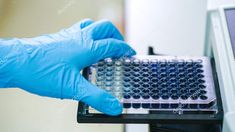Introduction:
Enzyme-Linked Immunosorbent Assay (ELISA) is a powerful and widely used immunological technique that plays a crucial role in various fields, including medical diagnostics, pharmaceutical research, and environmental monitoring. ELISA allows the detection and quantification of specific proteins, antibodies, antigens, and other biomolecules. Over the years, several variants of ELISA have been developed to suit different applications, each with its unique features and advantages.
Direct ELISA:
Direct ELISA is the simplest form of this technique. It involves immobilizing the antigen directly onto a solid surface, such as a microplate. The primary antibody, specific to the target antigen, is then added and subsequently detected by a labeled secondary antibody. This secondary antibody is conjugated to an enzyme, such as horseradish peroxidase (HRP) or alkaline phosphatase (AP). The enzyme produces a detectable signal when it reacts with a substrate, allowing the quantification of the target molecule.
Direct ELISA is rapid and straightforward, making it suitable for initial screenings. However, it may have limitations in terms of sensitivity and specificity compared to other ELISA variants.
Indirect ELISA:
Indirect ELISA is a more sensitive and versatile variant. In this method, the antigen is immobilized on the solid surface, and a primary antibody binds specifically to the target. Unlike direct ELISA, an additional step involves the introduction of a secondary antibody labeled with an enzyme. This secondary antibody recognizes the primary antibody, amplifying the signal and enhancing sensitivity.
Indirect ELISA is advantageous in situations where the primary antibody detection might be challenging due to low abundance or other factors. However, the additional steps can extend the assay duration.
Sandwich ELISA:
Sandwich ELISA is particularly useful for detecting and quantifying antigens with multiple epitopes. In this approach, the antigen is sandwiched between two antibodies – a capture antibody and a detection antibody. The capture antibody is immobilized on the solid surface, capturing the target antigen. The detection antibody, labeled with an enzyme, binds to a different epitope on the antigen, forming a “sandwich.” This method enhances specificity and is highly sensitive.
Sandwich ELISA is commonly used in clinical diagnostics, where precise quantification of specific biomarkers is crucial. Its sensitivity and specificity make it a preferred choice in detecting diseases such as cancer and infectious disorders.
Competitive ELISA:
Competitive ELISA is employed when quantifying the concentration of a sample based on the competition between a labeled antigen and the sample antigen for binding to a limited number of antibodies. The labeled antigen and sample antigen compete for binding to the immobilized antibody on the solid surface. The degree of competition directly correlates with the concentration of the antigen in the sample.
Competitive ELISA is often used in hormone level assays and drug detection, providing a quantitative measure of the analyte’s concentration.
Reverse ELISA:
Reverse ELISA, also known as capture ELISA, reverses the conventional order of the assay. Instead of immobilizing the antibody, the antigen is immobilized on the solid surface. The primary antibody is then introduced, followed by a labeled secondary antibody for detection. This variant is particularly useful when the antibody is challenging to obtain or conjugate with an enzyme.
Reverse ELISA offers flexibility in antibody selection, making it advantageous in situations where obtaining or conjugating antibodies is a limiting factor.
Conclusion:
In conclusion, the diverse variants of ELISA cater to the specific needs of various applications. Direct, indirect, sandwich, competitive, and reverse ELISA each have unique advantages, allowing researchers and diagnosticians to choose the most suitable method based on the characteristics of the target molecule and the goals of the assay. As technology advances, ELISA continues to evolve, maintaining its status as a cornerstone in immunoassays and contributing significantly to scientific and medical advancements.















